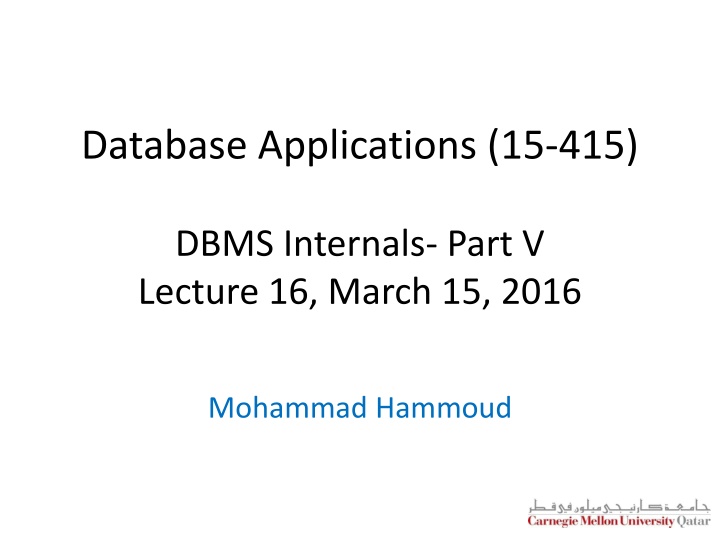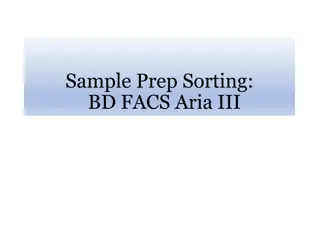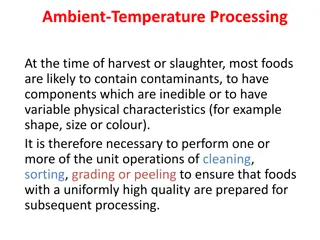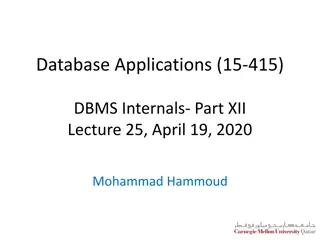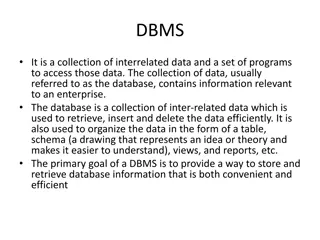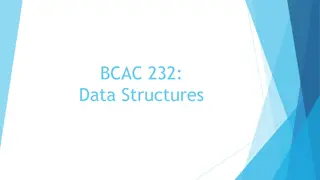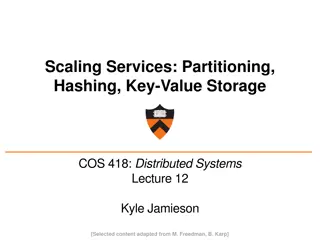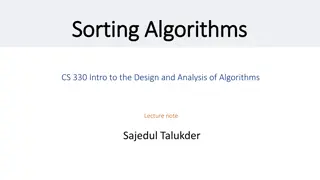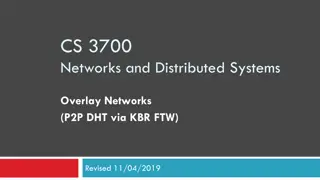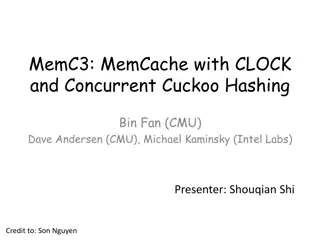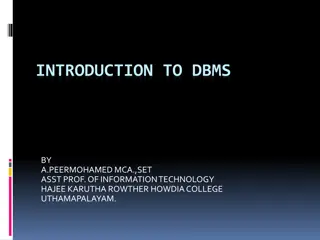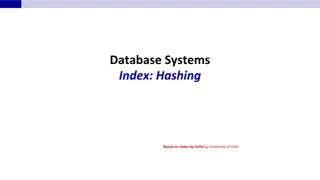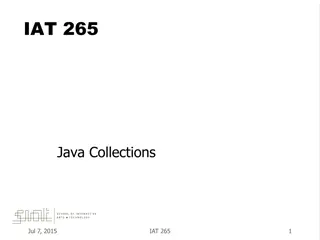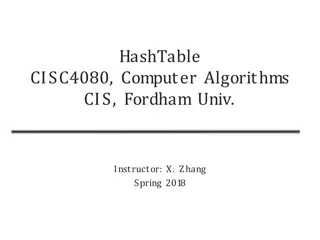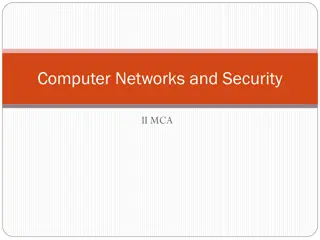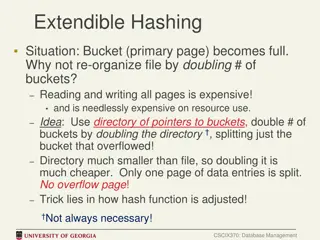DBMS Internals: Hashing and External Sorting
Today's DBMS session covered hash-based indexes and external sorting, exploring topics such as linear hashing, sorting algorithms, and database layers. Linear Hashing provides a flexible approach to dealing with insertions and deletions, offering an alternative to Extendible Hashing. The session delved into the workings of Linear Hashing, including its hash functions, bucket splitting mechanisms, and utilization of overflow pages.
Download Presentation

Please find below an Image/Link to download the presentation.
The content on the website is provided AS IS for your information and personal use only. It may not be sold, licensed, or shared on other websites without obtaining consent from the author.If you encounter any issues during the download, it is possible that the publisher has removed the file from their server.
You are allowed to download the files provided on this website for personal or commercial use, subject to the condition that they are used lawfully. All files are the property of their respective owners.
The content on the website is provided AS IS for your information and personal use only. It may not be sold, licensed, or shared on other websites without obtaining consent from the author.
E N D
Presentation Transcript
Database Applications (15-415) DBMS Internals- Part V Lecture 16, March 15, 2016 Mohammad Hammoud
Today Last Session: DBMS Internals- Part IV Tree-based (i.e., B+ Tree cont d) and Hash-based (i.e., Extendible Hashing) indexes Today s Session: DBMS Internals- Part V Hash-based indexes (continue) and External Sorting Announcements: Project 2 is due today by midnight. Student demos will be conducted on Thursday/Tuesday PS3 is due on Thursday, March 24th Project 3 will be posted on Thursday, March 17th
DBMS Layers Queries Query Optimization and Execution Continue Relational Operators Files and Access Methods Transaction Manager Recovery Manager Buffer Management Lock Manager Disk Space Management DB
Outline Linear Hashing Why Sorting? In-Memory vs. External Sorting A Simple 2-Way External Merge Sorting General External Merge Sorting Optimizations: Replacement Sorting, Blocked I/O and Double Buffering
Linear Hashing Another way of adapting gracefully to insertions and deletions (i.e., pursuing dynamic hashing) is to use Linear Hashing (LH) In contrast to Extendible Hashing, LH Does not require a directory Deals naturally with collisions Offers a lot of flexibility w.r.t the timing of bucket split (allowing trading off greater overflow chains for higher average space utilization)
How Linear Hashing Works? LH uses a family of hash functions h0, h1, h2, ... hi(key) = h(key) mod(2iN); N = initial # buckets his some hash function (range is not 0 to N-1) If N = 2d0, for some d0, hi consists of applying hand looking at the last di bits, where di = d0 + i hi+1doubles the range of hi(similar to directory doubling)
How Linear Hashing Works? (Contd) LH uses overflow pages, and chooses buckets to split in a round-robin fashion Buckets split in this round Splitting proceeds in rounds A round ends when all NR (for round R) initial buckets are split Buckets 0 to Next-1 have been split; Next to NR yet to be split Current round number is referred to as Level Next Buckets that existed at the beginning of this round: this is the range of h Level split image buckets created in this round
Linear Hashing: Searching For Entries To find a bucket for data entry r, findhLevel(r): If hLevel(r) in range `Next to NR , r belongs there Else, r could belong to bucket hLevel(r) or bucket hLevel(r) + NR; must apply hLevel+1(r) to find out Level=0, N=4 Example: search for 5* PRIMARY PAGES h h 0 1 Next=0 44* 36* 32* 000 00 Level = 0 5* = 101 h0 01 Data entry r with h(r)=5 9* 5* 25* 001 01 14*18*10*30* Primary bucket page 10 010 31*35* 7* 11* 011 11
Linear Hashing: Inserting Entries Find bucket as in search If the bucket to insert the data entry into is full: Add an overflow page and insert data entry (Maybe) Split Next bucket and increment Next Some points to Keep in mind: Unlike Extendible Hashing, when an insert triggers a split, the bucket into which the data entry is inserted is not necessarily the bucket that is split As in Static Hashing, an overflow page is added to store the newly inserted data entry However, since the bucket to split is chosen in a round-robin fashion, eventually all buckets will be split
Linear Hashing: Inserting Entries Example: insert 43* Level = 0 43* = 101011 h0 Level=0, N=4 11 PRIMARY PAGES h h 0 1 Next=0 44* 36* 32* 000 00 9* 5* 25* 001 01 14*18*10*30* 10 010 31*35* 7* 11* 011 11 Add an overflow page and insert data entry
Linear Hashing: Inserting Entries Example: insert 43* Level = 0 43* = 101011 h0 Level=0, N=4 11 PRIMARY PAGES OVERFLOW PAGES h h 0 1 Next=0 44* 36* 32* 000 00 9* 5* 25* 001 01 14*18*10*30* 10 010 Split Next bucket and increment Next 31*35* 7* 11* 43* 011 11
Linear Hashing: Inserting Entries Example: insert 43* Level = 0 43* = 101011 h0 Level=0, N=4 11 PRIMARY PAGES OVERFLOW PAGES h h Next=0 0 1 32* 000 00 9* 5* 25* 001 01 14*18*10*30* 10 010 31*35* 7* 11* 011 11 Almost there 43* 44* 36* 00 100
Linear Hashing: Inserting Entries Example: insert 43* Level = 0 43* = 101011 h0 Level=0, N=4 11 PRIMARY PAGES OVERFLOW PAGES h h 0 1 32* 000 00 Next=1 9* 5* 25* 001 01 14*18*10*30* 10 010 31*35* 7* 11* 011 11 FINAL STATE! 43* 44* 36* 00 100
Linear Hashing: Inserting Entries Another Example: insert 50* Level=0, N= 4 PRIMARY PAGES OVERFLOW PAGES Level = 0 50* = 110010 h0 h1 h 0 10 32* 000 00 9* 25* 001 01 66* 10 18* 10* 34* 010 Next=3 43* 7* 11* 31* 35* 011 11 44*36* 100 00 5* 37*29* 101 01 Add an overflow page and insert data entry 14* 30* 22* 110 10
Linear Hashing: Inserting Entries Another Example: insert 50* Level=0, N= 4 PRIMARY PAGES OVERFLOW PAGES Level = 0 50* = 110010 h0 h1 h 0 10 32* 000 00 9* 25* 001 01 66* 10 18* 10* 34* 010 50* Next=3 43* 7* 11* 31* 35* 011 11 44*36* 100 00 Split Next bucket and increment Next 5* 37*29* 101 01 14* 30* 22* 110 10
Linear Hashing: Inserting Entries Another Example: insert 50* Level=0 PRIMARY PAGES OVERFLOW PAGES h1 h 0 Level = 0 50* = 110010 h0 00 000 32* 10 001 01 9* 25* 10 010 50* 66* 18* 10*34* Next=3 011 11 35* 11* 43* 100 00 44* 36* 101 11 5* 29* 37* Almost there 14* 30* 22* 110 10 31*7* 11 111
Linear Hashing: Inserting Entries Another Example: insert 50* Level=0 PRIMARY PAGES OVERFLOW PAGES h1 h 0 Next=0 Level = 0 50* = 110010 h0 00 000 32* 10 001 01 9* 25* 10 010 50* 66* 18* 10*34* 011 11 35* 11* 43* 100 00 44* 36* 101 11 5* 29* 37* Almost there 14* 30* 22* 110 10 31*7* 11 111
Linear Hashing: Inserting Entries Another Example: insert 50* Level=1 PRIMARY PAGES OVERFLOW PAGES h1 h 0 Next=0 Level = 0 50* = 110010 h0 00 000 32* 10 001 01 9* 25* 10 010 50* 66* 18* 10*34* 011 11 35* 11* 43* 100 00 44* 36* 101 11 5* 29* 37* FINAL STATE! 14* 30* 22* 110 10 31*7* 11 111
Linear Hashing: Deleting Entries Deletion is essentially the inverse of insertion If the last bucket in the file is empty, it can be removed and Next can be decremented If Next is zero and the last bucket becomes empty Next is made to point to bucket M/2 -1 (where M is the current number of buckets) Level is decremented The empty bucket is removed The insertion examples can be worked out backwards as examples of deletions!
DBMS Layers Queries Query Optimization and Execution But, before we will discuss Sorting Relational Operators Files and Access Methods Transaction Manager Recovery Manager Buffer Management Lock Manager Disk Space Management DB
Outline Linear Hashing Why Sorting? In-Memory vs. External Sorting A Simple 2-Way External Merge Sorting General External Merge Sorting Optimizations: Replacement Sorting, Blocked I/O and Double Buffering
When Does A DBMS Sort Data? Users may want answers in some order SELECT FROM student ORDER BY name SELECT S.rating, MIN (S.age) FROM Sailors S GROUP BY S.rating Bulk loading a B+ tree index involves sorting Sorting is useful in eliminating duplicates records The Sort-Merge Join algorithm involves sorting (next session!)
Outline Linear Hashing Why Sorting? In-Memory vs. External Sorting A Simple 2-Way External Merge Sorting General External Merge Sorting Optimizations: Replacement Sorting, Blocked I/O and Double Buffering
In-Memory vs. External Sorting Assume we want to sort 60GB of data on a machine with only 8GB of RAM In-Memory Sort (e.g., Quicksort) ? Yes, but data do not fit in memory What about relying on virtual memory? In this case, external sorting is needed In-memory sorting is orthogonal to external sorting!
Outline Linear Hashing Why Sorting? In-Memory vs. External Sorting A Simple 2-Way External Merge Sorting General External Merge Sorting Optimizations: Replacement Sorting, Blocked I/O and Double Buffering
A Simple Two-Way Merge Sort IDEA: Sort sub-files that can fit in memory and merge Let us refer to each sorted sub-file as arun Algorithm: Pass 1: Read a page into memory, sort it, write it 1-page runsare produced Passes 2, 3, etc.,: Merge pairs (hence, 2-way) of runs to produce longer runs until only one run is left
A Simple Two-Way Merge Sort Algorithm: Pass 1: Read a page into memory, sort it, write it ONE How many buffer pages are needed? Passes 2, 3, etc.,: Merge pairs (hence, 2-way) of runs to produce longer runs until only one run is left THREE How many buffer pages are needed? INPUT 1 OUTPUT INPUT 2 Main memory buffers Disk Disk
2-Way Merge Sort: An Example 6,2 2 Input File 3,4 9,4 8,7 5,6 3,1 PASS 0 1-Page Runs 1,3 2 3,4 2,6 4,9 7,8 5,6 PASS 1 4,7 8,9 1,3 5,6 2,3 4,6 2-Page Runs 2 PASS 2 2,3 4,4 6,7 8,9 1,2 3,5 6 4-Page Runs PASS 3 1,2 2,3 3,4 4,5 6,6 7,8 8-Page Runs 9
2-Way Merge Sort: I/O Cost Analysis If the number of pages in the input file is 2k How many runs are produced in pass 0 and of what size? 2k 1-page runs How many runs are produced in pass 1 and of what size? 2k-1 2-page runs How many runs are produced in pass 2 and of what size? 2k-2 4-page runs How many runs are produced in pass k and of what size? 2k-k 2k-page runs (or 1 run of size 2k) For N number of pages, how many passes are incurred? How many pages do we read and write in each pass? 2N What is the overall cost? 1 + log2 N ) 1 + 2 ( log N N 2
2-Way Merge Sort: An Example 6,2 2 Input File 3,4 9,4 8,7 5,6 3,1 PASS 0 1-Page Runs 1,3 2 3,4 2,6 4,9 7,8 5,6 PASS 1 4,7 8,9 1,3 5,6 2,3 4,6 2-Page Runs 2 1 + log2 8 PASS 2 = 4 passes 2,3 4,4 6,7 8,9 1,2 3,5 6 4-Page Runs PASS 3 1,2 2,3 3,4 4,5 6,6 7,8 Formula Check: log ( N ) 1 + 2 N 8-Page Runs 2 = (2 8) (3 + 1) = 64 I/Os Correct! 9
Outline Linear Hashing Why Sorting? In-Memory vs. External Sorting A Simple 2-Way External Merge Sorting Optimizations: Replacement Sorting, Blocked I/O and Double Buffering General External Merge Sorting
B-Way Merge Sort How can we sort a file with N pages using B buffer pages? Pass 1: use B buffer pages This will produce sorted B-page runs Pass 2, , etc.: merge runs / N B INPUT 1 . . . . . . INPUT 2 . . . OUTPUT INPUT B-1 Disk Disk B Main memory buffers
B-Way Merge Sort: I/O Cost Analysis I/O cost = 2N Number of passes + 1 log / N B Number of passes = 1 B Assume the previous example (i.e., 8 pages), but using 5 buffer pages (instead of 2) I/O cost = 32 (as opposed to 64) Therefore, increasing the number of buffer pages minimizes the number of passes and accordingly the I/O cost!
Number of Passes of B-Way Sort N 100 1,000 10,000 100,000 1,000,000 10,000,000 100,000,000 1,000,000,000 30 B=3 B=5 B=9 B=17 B=129 B=257 7 4 3 10 5 4 13 7 5 17 9 6 20 10 7 23 12 8 26 14 9 15 10 2 3 4 5 5 6 7 8 1 2 2 3 3 4 4 5 1 2 2 3 3 3 4 4 High Fan-in during merging is crucial! How else can we minimize I/O cost?
Outline Linear Hashing Why Sorting? In-Memory vs. External Sorting A Simple 2-Way External Merge Sorting General External Merge Sorting Optimizations: Replacement Sorting, Blocked I/O and Double Buffering
Replacement Sort With a more aggressive implementation of B-way sort, we can write out runs of 2 B (on average) internally sorted pages This is referred to as replacement sort 2 12 8 3 4 10 5 CURRENT SET INPUT OUTPUT IDEA: Pick the tuple in the current set with the smallest value that is greater than the largest value in the output buffer and append it to the output buffer
Replacement Sort With a more aggressive implementation of B-way sort, we can write out runs of 2 B (on average) internally sorted pages This is referred to as replacement sort 2 12 8 3 4 10 5 CURRENT SET INPUT OUTPUT When do we terminate the current run and start a new one?
Blocked I/O and Double Buffering So far, we assumed random disk accesses Would cost change if we assume that reads and writes are done sequentially? Yes How can we incorporate this fact into our cost model? Use bigger units (this is referred to as Blocked I/O) Mask I/O delays through pre-fetching (this is referred to as double buffering)
Blocked I/O Normally, we go with B buffers of size (say) 1 page INPUT 1 INPUT 2 . . . . . . . . . OUTPUT INPUT 5 Disk Disk
Blocked I/O Normally, we go with B buffers of size (say) 1 page INSTEAD: let us go with B/b buffers, of size b pages INPUT 1 OUTPUT INPUT 2 . . . . . . Disk Disk 3 Main memory buffers
Blocked I/O Normally, we go with B buffers of size (say) 1 page INSTEAD: let us go with B/b buffers, of size b pages What is the main advantage? Fewer random accesses (as some of the pages will be arranged sequentially!) What is the main disadvantage? Smaller fan-in and accordingly larger number of passes!
Double Buffering Normally, when, say INPUT1 is exhausted We issue a read request and We wait INPUT 1 INPUT 2 . . . . . . . . . OUTPUT INPUT B-1 Disk Disk B Main memory buffers
Double Buffering INSTEAD: pre-fetch INPUT1 into a `shadow block When INPUT1 is exhausted, issue a read BUT, also proceed with INPUT1 Thus, the CPU can never go idle! INPUT 1 INPUT 1' INPUT 2 OUTPUT INPUT 2' OUTPUT' b block size Disk INPUT k Disk INPUT k' B main memory buffers, k-way merge
Next Class Queries Query Optimization and Execution Continue Relational Operators Files and Access Methods Transaction Manager Recovery Manager Buffer Management Lock Manager Disk Space Management DB
